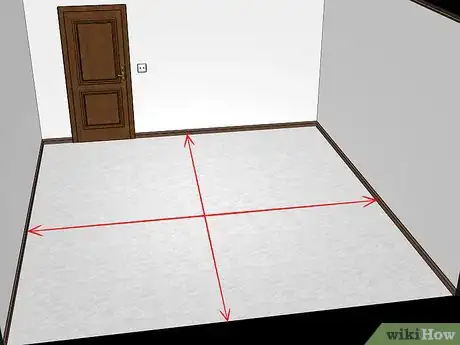This article was co-authored by Art Fricke. Art Fricke is a home renovation and repair specialist and the owner of Art Tile & Renovation based in Austin, Texas. With over 10 years of experience, he specializes in bathroom and kitchen renovations. Art focuses on a single contractor approach to customized renovation work, and performs projects such as installing custom tile showers, fixing tiled shower leaks, replacing cracked tiles, and installing floor and wall tile.
There are 8 references cited in this article, which can be found at the bottom of the page.
This article has been viewed 45,403 times.
Tile is a great option for your high-traffic living room—it’s durable, easy-to-maintain, and stylish. Choose what type of tile you’d like to use, from traditional ceramic to springy cork to decorative mosaic. Take into consideration how large your living room is and what size and color of tile will look best. Finally, start shopping around to compare the different options available to you both online and at home improvement stores.
Steps
Choosing a Type of Tile
-
1Look into ceramic wood if you like the look of hardwood floors. Hardwood floors are great, but they scratch easily and can be hard to maintain. If you like the look but don’t want the hassle, choose ceramic wood—it’s really durable and is resistant to both moisture and scratching, which means your floors will look nice for a really long time.[1]
- You can buy ceramic wood that imitates the look of almost any kind of species of tree.
- Keep in mind that real wood floors have a softer, warmer feel than ceramic wood, which can feel hard and cold. However, ceramic wood floors are easier to clean than real wood floors.
-
2Choose ceramic or porcelain tile for a hardy, dense flooring option. Ceramic and porcelain are very similar, but porcelain is just a little denser and a little less porous than ceramic. If you have kids, this might be a good option as it can withstand a bit more action (and it’s less likely to stain).[2] Ceramic tiles are comparatively more brittle.[3]
- Porcelain does usually cost a little bit more than ceramic does, but it also usually lasts a little bit longer.
- Porcelain tiles come in lots of different patterns and colors, so you will have lots of options!
Advertisement -
3Pick cork for a soft, quiet, moisture-resistant tile. Cork is great if you’re looking for an option that’ll be a little softer and warmer on your feet. Cork is also a natural insulator so it could help you save money on your heating during the cold months. It’s also a great option if you want to have bold walls and furniture, as the neutral coloring won’t distract from any other design elements you want to implement.
- Cork is less expensive than most other types of tile, and it’s environmentally friendly.
- You can get cork in its natural color, or choose another color option if you prefer.
- Cork is softer than other kinds of floors, so it is a great option for kids. Dropped dishes and toys will be less likely to break if they fall on a cork floor.
-
4Opt for bamboo floors for a sustainable and soft tile. They’re easy to clean and water-resistant. However, they’re not great for humid climates (constant water in the atmosphere could warp the bamboo and potentially cause it to grow mold), and they scratch more easily than other types of tile. If you have little kids or pets, this might not be the best flooring option for you.
- Bamboo only takes 3 to 5 years to mature, whereas trees can take 20 years or more to mature, meaning that bamboo is more renewable and better for the environment.
- Opt for bamboo if you are going for a minimalist look in your home.
-
5Install mosaic tile for a patterned, textured flooring option. Mosaic might seem odd for a living room, but it can really add a lot of color, texture, and art to your living space. It’s great if you want the rest of the room to be simple but still want a burst of color or design in the room. Mosaic is great if you are interested in creating a design yourself, and it lasts a long time and is easy to clean.[4]
- Mosaic is more expensive than most other tile options, and it can be really hard to install yourself. Most likely, you’ll have to hire someone to put it in for you.
- Also, keep in mind that mosaic can be difficult to repair if a tile breaks or grout needs to be replaced, so it is best for low-traffic areas of your home.
-
6Use slate for a slip-resistant, modern-looking style. Slate is great for high-traffic areas, and all it needs to be cleaned is plain water and a mop. You can choose different colors of slate, like gray-blue, green, brown, and even burnt orange. Slate doesn’t retain heat very well, though, so you might want to consider getting a rug to use in your living room, too.[5]
- Slate will cost more than most other tiles will, but it will also outlast materials like ceramic and porcelain.
-
7Select marble for an elegant, polished-looking tile for your living room. Marble is really durable and can withstand a lot of traffic. You can also find marble in almost any color you’d like, which makes it a great custom choice. Marble is more absorbent than a lot of other tiles, so there is a chance that it could get stained over time.[6]
- Marble generally costs about $5 more per square foot than other types of tile.
- Marble can be very slippery because of how smooth it is, so it may increase the risk of people falling in your home. This is not a good option for homes with children or elderly, and you may still need to cover it with a rug to reduce the risk of slipping on it.
-
8Get terracotta tiles for a rustic, red-clay floor. Terracotta provides a really specific look that resembles the color of fired clay, so the tile ends up looking like a mix of burnt orange and red hues. It’s a long-lasting material, but you do have to put a seal on it, otherwise, it is really absorbent and stains easily.[7]
- Terracotta is a budget-friendly option, costing just $3 to $7 per square foot.
- This is a great option if your live in a hot or humid climate since terracotta will keep heat in during cooler times of the year.
-
9Decide on terrazzo tile for a shiny, long-lasting floor. Terrazzo is made up of chips from different materials, like marble, quartz, granite, and glass. Those materials are ground up and mixed together, and then they’re polished to give the terrazzo its shiny finish. The biggest concern with terrazzo is that it can be extremely slippery so it might not be the best option if you have kids or elderly family members living at home.[8]
- Terrazzo is also really expensive, sometimes costing as much as $40 per square foot.
Determining Color and Style
-
1Make a small room look bigger by choosing lighter-colored tiles. Ceramic and porcelain are good options for small living rooms, as are any other tiles that come in white, beige, or cream colors. Light colors make a room look more open.[9]
- Ultimately, you want your tiles to be a color you won’t mind looking at every day. Bring home samples of different colors and styles to see what looks best in your living room before making a final decision.
-
2Pick darker-colored tiles to make your room seem cozier. Dark tiles absorb light, thus making a room look smaller. If you choose to use dark tiles, like black, dark gray, forest green, or brown, choose lighter and brighter colors for the furniture, walls, and curtains so that the room doesn’t become claustrophobic.[10]
- Light furniture and bright curtains would look great with a dark floor.
- Keep in mind that dark colors hide stains and dirt easier, but chips will be more noticeable.
-
3Choose unique colors and patterns to personalize the room. You don’t have to stick with beige, cream, black, brown, or gray floors. Buy tiles that come with patterns on them, like flowers or geometric shapes, or alternate black and white tiles to create a checkerboard. Don’t be afraid to think outside the box and use bright colors, like red, yellow, green, or even pink to personalize your living room.[11]
- Think of your floor as a canvas. You can design it however you’d like!
- Combine dark and light tiles for contrast, or go with a pattern that you like.
-
4Use large tiles to make your living room appear more spacious. The bigger the tiles, the bigger your room will appear. Look for tiles that are 13 by 13 inches (33 by 33 cm) or larger. There will be fewer grout lines in your living room, which will make the space look more streamlined.[12]
- Larger tiles also mean less grout that you’ll inevitably have to clean.
- Larger tiles also look more modern than small tiles. However, keep in mind that small tiles are more slip-resistant than large tiles.
Expert AnswerQWhat is the typical width of grout lines?
Art Fricke is a home renovation and repair specialist and the owner of Art Tile & Renovation based in Austin, Texas. With over 10 years of experience, he specializes in bathroom and kitchen renovations. Art focuses on a single contractor approach to customized renovation work, and performs projects such as installing custom tile showers, fixing tiled shower leaks, replacing cracked tiles, and installing floor and wall tile.Home Renovation & Repair Specialist
 EXPERT ADVICEAnswer from Art Fricke:
EXPERT ADVICEAnswer from Art Fricke:Mostly, people prefer to have 8th-inch grout lines (instead of 16th-inch lines). This is because tiles are not exactly uniform in size, and thicker lines show the variation more clearly. For example, if there is a difference of 64th of an inch in the width or height between two tiles, an 8th-inch grout line can camouflage it. However, with 16th-inch grout lines, the difference is noticeable.
-
5Lay out your tiles in a pattern to create a focal point in the room. Install the tiles at a diagonal to the wall, or create a layered pattern to add depth and make your living room look wider. Consider making a herringbone pattern, or use mosaic tiles to create a design on the floor.[13]
- Browse magazine and websites for some decoration inspiration. There are lots of fun ways to arrange tiles apart from the classic methods you see most often.
-
6Arrange the tiles flush against the wall to make a room look orderly. For simple and quick installation, plan on installing your tiles in a straight row from one end of the room to the other. You won’t have to worry about cutting multiple tiles to fit at an angle, and the floor will look very neat and organized.[14]
- A plain floor gives you a lot of creative space to decorate with art and furniture in the living room.
-
7Choose matching grout to make a room look more cohesive. If you don’t want your floor to necessarily draw a lot of attention, opt for grout that matches the tiles you choose. The similar colors will make the tiles look like they are flowing together, which in turn will make the living room look seamless.[15]
- An off-white or gray grout will tie light tiles together, drawing less attention down to the ground.
- Choose grout that matches the tile color for a seamless look.
- You can make 8th-inch grout lines.[16]
- Tiles are not exactly uniform in size. For example, if there is a difference of 64th of an inch in their width or height, an 8th-inch grout line can camouflage it. But with 16th-inch grout lines, the difference is noticeable.[17]
-
8Decide on contrasting grout to create an eye-catching pattern. A grout that is a contrasting color to your tile will pop and stand out quickly. It’s a great way to make a floor look stylized. Choose this option if you want your floor to be more of a focal point in the living room.[18]
- A dark grout with light tiles will give your tiles more contrast and create more of a pattern. Likewise, dark tile with light grout will achieve the same contrast.
Shopping for Tile
-
1Measure the room to estimate how much the tile will cost. Take a tape measure and determine the length and width of your living room. Multiply the length by the width to get the total square footage. For example, if your living room is 15 by 20 feet (4.6 by 6.1 m), you’ll need enough tile for 300 square feet (27.87 square meters).
- Measuring your living room correctly will help you make decisions about brands and companies based on the cost per square foot.
-
2Take pictures of your furniture and paint to see how things go together. Snap a few photos of your living room before you head out to the store. Take into account the trim, doors, curtains, furniture, and artwork that you have in the living room. It’ll still be hard to tell exactly how things will look together, but having the photos should help you trim down your options.
- If you have fabric or paint swatches from when you painted or bought new furniture, take them along with you, too.
- Make sure to bring the pictures of the room along with you when you go shopping for tile.
-
3Get samples of different tiles to see how they look in your living room. Order samples online or visit home improvement stores in person to get samples. Most samples should be free, but some online companies might charge a small cost to cover their shipping expenses. Look at tiles from multiple companies to find a style and price that fit your needs.[19]
- Keep in mind that colors often look different online or in the store than they do in person or in your living room.
- Check the tiles at different times of day to see how they look with different levels of light.
-
4Ask about sales and discounts from different providers. Find out when companies have their annual or semi-annual sales. Ask if you get a discount if you open up a credit card through the store. Learn about rewards systems. Don’t hesitate to ask about deals—some stores don’t promote their sales very heavily and you don’t want to miss out on something just because you didn’t ask.[20]
- Before buying tile from any location, you could write down the name and details for the tile and then search it online to see if you find it anywhere else for a less expensive price.
- Watch for closeouts and discontinued tile, which you may be able to get for a very low price.
-
5Buy the tile you want from the distributor that has the best price. Once you’ve done your research and made your decision, it’s time to actually buy the tile. Arrange to have it delivered when you’ll be home so you can double-check that you were sent the right order. If you haven’t already, now is a good time to think about whether you want to install the tile yourself or hire a professional to do it for you.[21]
- If you can, double-check the tile for any damage or cracks right when it’s delivered. If there are any broken tiles, call the company and arrange for replacements right away. That way there will be no discrepancy about when the damage actually occurred.
Expert Q&A
-
QuestionWhy is ceramic tile more brittle?
 Art FrickeArt Fricke is a home renovation and repair specialist and the owner of Art Tile & Renovation based in Austin, Texas. With over 10 years of experience, he specializes in bathroom and kitchen renovations. Art focuses on a single contractor approach to customized renovation work, and performs projects such as installing custom tile showers, fixing tiled shower leaks, replacing cracked tiles, and installing floor and wall tile.
Art FrickeArt Fricke is a home renovation and repair specialist and the owner of Art Tile & Renovation based in Austin, Texas. With over 10 years of experience, he specializes in bathroom and kitchen renovations. Art focuses on a single contractor approach to customized renovation work, and performs projects such as installing custom tile showers, fixing tiled shower leaks, replacing cracked tiles, and installing floor and wall tile.
Home Renovation & Repair Specialist Ceramic tile tends to be very brittle because it is mostly clay with a thin layer of porcelain baked on top of it.
Ceramic tile tends to be very brittle because it is mostly clay with a thin layer of porcelain baked on top of it.
References
- ↑ https://www.remodelingcalculator.org/7-tips-on-choosing-the-right-floor-tile-for-every-room/
- ↑ https://www.remodelingcalculator.org/7-tips-on-choosing-the-right-floor-tile-for-every-room/
- ↑ Art Fricke. Home Renovation & Repair Specialist. Expert Interview. 1 July 2020.
- ↑ https://www.tileshop.com/category/inspiration/tile-ideas/living-room.do
- ↑ https://gemmill.com.au/blog/11-different-types-of-tile-flooring/
- ↑ https://gemmill.com.au/blog/11-different-types-of-tile-flooring/
- ↑ https://www.hgtv.com/design/decorating/design-101/the-pros-and-cons-of-terra-cotta-tile
- ↑ https://gemmill.com.au/blog/11-different-types-of-tile-flooring/
- ↑ https://www.homestolove.co.nz/inspiration/interior_style/how-to-choose-the-right-tiles-for-your-interior
- ↑ https://www.homestolove.co.nz/inspiration/interior_style/how-to-choose-the-right-tiles-for-your-interior
- ↑ https://freshome.com/28-creative-tile-ideas-bath-and-beyond/
- ↑ https://www.homestolove.co.nz/inspiration/interior_style/how-to-choose-the-right-tiles-for-your-interior
- ↑ https://www.homestolove.co.nz/inspiration/interior_style/how-to-choose-the-right-tiles-for-your-interior
- ↑ https://www.homestolove.co.nz/inspiration/interior_style/how-to-choose-the-right-tiles-for-your-interior
- ↑ https://www.homestolove.co.nz/inspiration/interior_style/how-to-choose-the-right-tiles-for-your-interior
- ↑ Art Fricke. Home Renovation & Repair Specialist. Expert Interview. 1 July 2020.
- ↑ Art Fricke. Home Renovation & Repair Specialist. Expert Interview. 1 July 2020.
- ↑ https://www.homestolove.co.nz/inspiration/interior_style/how-to-choose-the-right-tiles-for-your-interior
- ↑ https://www.apartmenttherapy.com/how-to-shop-for-tile-207920
- ↑ https://www.apartmenttherapy.com/how-to-shop-for-tile-207920
- ↑ https://www.apartmenttherapy.com/how-to-shop-for-tile-207920
- ↑ https://www.remodelingcalculator.org/7-tips-on-choosing-the-right-floor-tile-for-every-room/
















































































